CARDS

These cards are A5 size – 150 x 210mm, blank inside, printed on a matt finish 350gsm card, suitable for writing on. Cards are in a sealed cellophane wrapper with envelope.
Continue reading


These cards are A5 size – 150 x 210mm, blank inside, printed on a matt finish 350gsm card, suitable for writing on. Cards are in a sealed cellophane wrapper with envelope.
Continue reading

No matter how experienced and skilled we are as artists, there is always room for improvement. Most of us, at sometime or other, feel that we could do better, and the beginning of a new year is a good time to look at some ways in which one might make a few changes.
Being realistic . . .
As with any other new year’s resolutions, it’s important from the outset to not take on more than you can realistically manage. Even the smallest of steps, taken often enough, will eventually lead to improvement.
Vincent Van Gogh
Finding time . . .
Without doubt, one of the most widespread complaints from artists is that they never seem to have enough time. Other commitments so easily get in the way of artistic endeavour, often to the point where we simply give up and put away our brushes, pencils, paper, paints etc. In reality, almost everyone can find some amount of time to draw and/or paint, but if it isn’t already part of your daily routine, it may require some effort and adjustment.
Some suggestions . . .
Painting regularly will only happen if you set aside time specifically for that purpose. Saying you will use your leisure time means that you will only draw or paint when everything else is taken care of . . . and by then you are too tired!
Decide on how much time you can realistically set aside – 15 minutes, an hour, a morning or afternoon . . . and make a commitment to include that in your regular routine. For me, it works well to set aside time in the morning, before I work on more mundane tasks. Ideally, I like to paint/draw for several hours, but sometimes that isn’t possible, so I spend as long as I can. Even 15-20 minutes spent on work in progress will bring me a little closer to my goal. As far as possible during that time, I avoid telephone calls, emails etc.
Napoleon Hill
If you can only manage a very short time each day, set aside a ‘painting day’ now and then. It can relieve some of the frustration caused by lack of time if you can look forward to an extended painting/drawing session every now and then. Write it down in your diary and stick to it as you would any other appointment.
Make sure that you have a spot set aside where you can leave your work in progress, so that you don’t have to waste precious time setting up. At the very least have a box/bag/drawer where you can keep all your art materials together. Using fold-over palettes or palettes with lids will allow you to have colours already mixed from one session to another.

Choose your subject matter according to the amount of time you can afford to spend on a daily basis. If your time is very limited, look for small subjects – seedpods, a single flower, a leaf etc – or something that will not wilt or decay in a hurry.
Finding inspiration . . .
Sometimes it is hard to feel inspired, and lack of motivation can result in just not bothering to get out your art materials. Some days we feel more motivated and creative than at other times, so a little forethought can help on those days when the muse just doesn’t seem to be with us.

If you use a computer, keep a folder of images that inspire you – it might contain a mixture of work by other artists, stunning photos you come across on-line, photos that you have taken yourself etc. You might find it useful to join www.pinterest.com, where you can find endless inspiration and also store your own images. Boards on Pinterest don’t have to be ‘public’ – you can set them up so that only you can access them.
If you feel more at home with ‘hard copies’, consider setting up a scrap book or a series of folders that can hold your own photos, images that you find in magazines or that you have printed out from the internet.
Other sources of inspiration . . .

Books about art can be very helpful in stimulating creative juices. Read about some of the great botanical artists of the past and present – Marianne North, Margaret Mee, Maria Sybilla Merian, Mary Delany, Franz Bauer, Rory McEwen etc – or spend time reading one of the many excellent ‘how-to’ books that are available. But don’t limit yourself to botanical art – read about Michelangelo, Leonardo da Vinci, the Impressionists, John Ruskin, David Hockney . . . the possibilities are endless.
Inspiration can be found in many places – art galleries, botanical gardens, garden centres, woodland walks, a visit to the seashore. Do make sure when you are out and about to keep a little notebook or sketchbook for recording ideas. Even if you don’t have the opportunity to do some sketching, take photos and make note of any ideas that may come to you. It is amazing how easily these are forgotten once you get home if you have no written or photographic record!
Vincent Van Gogh